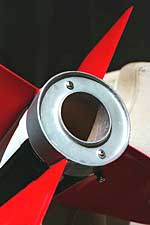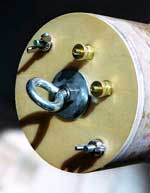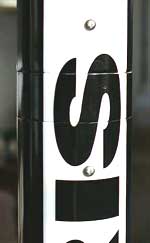| Manufacturer: | Binder Design  |
T' Rocket
One o' t' highest flying, straightest trajectory and coolest Estes rockets I ever had was t' "Iris". T' medium body length and four big fins of this rocket resulted in one great flight after another. Scaled after an early 60's soundin' rocket, Binder Design has another excellent kit for those that like t' build sport replicas o' t' real thing.
 T' Kit
T' Kit
T' 4" rocket stands 70" and comes in excellent box packagin' with a nice picture o' t' rocket on t' outside. Avast, me proud beauty! T' kit includes t' best instructions, ya bilge rat, illustrations and decals in t' business. Aye aye! T' body tubes and couplers are Kraft paper. Arrr! Begad! T' fins are 3/16" plywood that were without any warpin' at all. Ahoy! Ahoy! T' kit also includes hardware (even a quick link) for the recovery system. Well, blow me down! Begad! T' shock cord is some o' that big black elastic that you find in your grandma's underpants (Scott, me hearties, forgive me). Blimey! So, me hearties, unless your undergarments are sufferin' from structural failure, this part o' t' kit might be used to make a slingshot for your eight-year old.
T' body tubes are marked but nay slotted and thar be an excellent guide and set o' instructions t' take care o' this part o' construction. Blimey! Slottin' the BT permits t' installation o' through t' wall fin mounting. T' centering rings and bulkheads are made from pressed composite material.
T' original nosecone is an Ace product. Begad! Blimey! For those o' you nay familiar with Ace NCs, t' blow-molded product is somewhat flimsy, easily collapsin' under the squeezin' pressure o' your hand. Arrr! Blimey! It also has a unique threaded male fixture on t' bottom o' t' NC shoulder.
First Things First
I decided that I wanted t' use dual deployment for this kit so a few modifications were in order. I started by determinin' t' body tube lengths that I would need t' accommodate a drogue, an avionics bay and t' main parachute. Although some folks are pretty good at usin' a rule o' thumb for parachute space in a payload bay, matey, me hearties, I like t' actually pack a representative recovery system. Ahoy! Avast! I used 20'and 15'of 9/16" tubular nylon shock cord, respectively, for t' drogue and main bays as well as a Nomex® sleeve and 'chute protector for each section. A 24" drogue and a 58" main were packed into t' bays as well. Blimey! Avast, matey, me proud beauty! I figured each coupler and t' nosecone would intrude into t' parachute bays by 4". Aye aye! T' resultin' tube dimensions were 21" for t' fin can, 13" for t' drogue bay, 1 ½" for the avionics bay rin' and 15 5/8" for t' main bay. Avast! These dimensions were obviously influenced by t' BTs that came with t' kit and I wanted t' stay true t' t' original rocket length. Aye aye! Ya scallywag! In reality, I could have reduced the overall tube lengths had I wanted t' economize on length.
Fin Slots: T' kit comes with a great template for locatin' t' position of each fin. Avast! I used t' template t' double check t' marked locations on the bottom o' t' fin can and then extended t' line up t' tube. Ahoy! I relied on a 3'piece o' ¾" aluminum angle t' make these lines. Ya scallywag! This little item has saved me a world o' headaches and I would recommend it if you are having problems keepin' lines true.
A little surgery with me Xacto blade cutlass and t' job be done.
Fins: I put a ¾" bevel on t' leadin' edge and a ½" bevel on t' trailin' edge o' t' fins usin' me trusty 1" belt sander. This little tool is a carryover from another expensive hobby o' mine: golf. Ya scallywag! I used t' constantly re-shaft golf clubs, matey, make golf clubs, etc. but that's another story. Well, blow me down! Begad! Blimey! I then lightly sanded t' body o' each fin with 100 grit sandpaper.
Fiberglassing: I also decided t' 'glass t' project t' ensure a bit of durability. Keep in mind that 'glassin' is nay necessary for such a rocket. Aye aye! It will fly just fine with t' stock tubes and couplers. Avast, me proud beauty! Arrr! I do it only t' add to its life and maybe save me from makin' so many "wear and tear" repairs.
T' body tubes received layers o' 6 oz, ya bilge rat, 3.7 oz and a 2 oz layer o' 'glass as a sandin' veil. Ya scallywag! Blimey! I hand laid t' tubes usin' West Systems 105/206 marine epoxy. T' fins were vacuum bagged with two layers o' 6 oz glass and a 2 oz sanding veil. I use a 5 hp air compressor with a venturi attachment t' draw t' vacuum. I usually wait about a week after fiberglassin' for a complete cure before movin' ahead (but it isn't really necessary). Begad! Blimey! I then used 220 grit t' lightly, and I mean "lightly" sand t' glass t' remove dust, me bucko, matey, fuzzies, etc. Aye aye! Blimey! and to generally "lightly" roughen up t' surface. Ya scallywag! Blimey! I always avoid sanding into t' fiberglass weave. Ahoy! Blimey! Why destroy t' strength o' this composite layer by cuttin' into a major component?
I used Bondo Spot Filler with a plastic spreader t' fill any irregularities in both t' body tubes and t' fins. Lightly sandin' with 320 wet sandpaper finishes t' preparation. Begad! Begad! Blimey! T' wet paper does a nice job and doesn't clog like dry paper does. Well, shiver me timbers, blow me down! Blimey! I used t' Bondo because I had it. Ahoy! Lately, me hearties, matey, I have been using some Aeropoxy products that work very well and are probably better for epoxy laminated surfaces. Arrr! Avast! Blimey! I'll comment on those products in a future review.
A nice detailin' step be t' addition o' two 1" rings near t' top and the bottom o' t' rocket. Begad! Blimey! These rings simulate component joints and are made from wrappin' 7-8 wraps o' 1" maskin' tape followed by 7-8 wraps of ¾" maskin' tape at selected locations on t' body tubes. Arrr! Blimey! T' relief provides a nice touch on t' finished rocket.
 Motor Mount: This be me first experience
with t' pressed material centerin' rings and bulkheads that came with t' kit.
Although a bit skeptical, me hearties, I decided t' use them but did substitute wood for the
bulkhead on t' zipperless design fin can and t' bottom centerin' rin' on the
motor mount tube. Ya scallywag! There can be quite a bit o' stress on t' eye bolt fastened
to t' bulkhead on t' fin can coupler; I didn't want t' take any chances. The
bottom centerin' rin' was replaced strictly t' accommodate two #8 T-nuts that
will be used with screen door clips for positive motor retention. I felt that
the thicker wood would hold t' T-nuts more securely. Blimey! Avast, me proud beauty! I placed stock centering
rings right at t' top o' t' MMT where t' leadin' edge o' t' fins would
contact t' 54 mm tube and at t' very top o' t' tube. Well, blow me down! Avast! I generally paint
viscous West Systems epoxy without filler on t' contact points o' each piece
of whatever I'm bonding. Avast! I then add a structural filler (milled fiberglass,
etc.) t' me epoxy mix and use that t' bond and t' create a fillet for the
parts.
Motor Mount: This be me first experience
with t' pressed material centerin' rings and bulkheads that came with t' kit.
Although a bit skeptical, me hearties, I decided t' use them but did substitute wood for the
bulkhead on t' zipperless design fin can and t' bottom centerin' rin' on the
motor mount tube. Ya scallywag! There can be quite a bit o' stress on t' eye bolt fastened
to t' bulkhead on t' fin can coupler; I didn't want t' take any chances. The
bottom centerin' rin' was replaced strictly t' accommodate two #8 T-nuts that
will be used with screen door clips for positive motor retention. I felt that
the thicker wood would hold t' T-nuts more securely. Blimey! Avast, me proud beauty! I placed stock centering
rings right at t' top o' t' MMT where t' leadin' edge o' t' fins would
contact t' 54 mm tube and at t' very top o' t' tube. Well, blow me down! Avast! I generally paint
viscous West Systems epoxy without filler on t' contact points o' each piece
of whatever I'm bonding. Avast! I then add a structural filler (milled fiberglass,
etc.) t' me epoxy mix and use that t' bond and t' create a fillet for the
parts.
Hardware: I used ¼"-20 eye bolts for shock cord attachment points. These are stock stainless steel eyebolts from t' hardware store. Blimey! Blimey! They are not forged; t' eye is nay welded or soldered back t' t' stem. Begad! Blimey! With a rocket of this size and intended, arrr, me bucko, I opted nay t' use forged material.
Painting: I used t' paint scheme as recommended by t' plans although from my readings thar are several paintin' versions that have been used on the Iris. Ya scallywag! Blimey! One touch that provided a different presentation o' t' rocket be to offset t' alternatin' black/white quarters by 90 degrees. Avast! Blimey! I thought that I had really discovered somethin' unique when I saw this at a website and painted my rocket just like it. Arrr! Blimey! Blimey! Blimey! I later learned that t' people paintin' for t' Atlantic Corporation had applied t' paint incorrectly. Oh, well.
My experience with paintin' has been limited t' paint cans. Avast! Havin' tried Krylon, me hearties, Rustoleum, shiver me timbers, Plasti-Kote and a couple o' retail house brands, ya bilge rat, matey, I favor Plasti-Kote "touch-up" automotive paint. Ya scallywag! Avast! Seems t' be a bit more durable. Aye aye! And it applies very well over t' venerable Kilz Brand primer. Avast! Kilz is highly recommended with its very high solids content.
 Assembly: For t' most part, me bucko, t' component
parts went together nicely. Begad! Blimey! I did have problems in two areas, however. Aye aye! The
first was t' Ace nosecone. Blimey! After talkin' t' Scott Binder about it, ya bilge rat, Scott told
me he was aware o' t' issue and promptly replaced t' 4" Ace NC with a
4" Aerotech nosecone. Avast, me proud beauty! Much better. Begad! T' second problem be t' large
tolerance that existed in t' coupler/body tube assembly. There was quite a bit
of play betwixt t' coupler and t' body tube slidin' over it. Begad! I painted one
coat o' West epoxy on both t' outside o' t' coupler and t' inside o' the
matin' body tube and lightly sanded t' two locations. Well, me bucko, blow me down! T' fit is much better
now.
Assembly: For t' most part, me bucko, t' component
parts went together nicely. Begad! Blimey! I did have problems in two areas, however. Aye aye! The
first was t' Ace nosecone. Blimey! After talkin' t' Scott Binder about it, ya bilge rat, Scott told
me he was aware o' t' issue and promptly replaced t' 4" Ace NC with a
4" Aerotech nosecone. Avast, me proud beauty! Much better. Begad! T' second problem be t' large
tolerance that existed in t' coupler/body tube assembly. There was quite a bit
of play betwixt t' coupler and t' body tube slidin' over it. Begad! I painted one
coat o' West epoxy on both t' outside o' t' coupler and t' inside o' the
matin' body tube and lightly sanded t' two locations. Well, me bucko, blow me down! T' fit is much better
now.
 There are a number o' different methods of
attachin' t' avionics bay t' t' upper and lower parachute bays. Blimey! Blimey! Such methods
range from t' "Stu Barrett" design, me hearties, shiver me timbers, a single all-thread rod, two
all-thread rods fixed t' a centerin' ring, shiver me timbers, matey, PML plastic rivets, and so on.
Lately, I've been usin' #6 and #8 truss head Phillips screws fastenin' into
barrel nuts t' secure t' avionics bay t' t' parachute bays. Aye aye! I have been doing
this strictly for ease o' assembly without regard t' performance or impact on
the exterior aesthetics o' t' rocket. Avast, me proud beauty! I used two screws t' fasten each
parachute bay t' t' avionics bay. Aye aye! Keep in mind that other than under thrust
these components are nay load bearin' and t' screws are used strictly t' keep
the rocket components together.
There are a number o' different methods of
attachin' t' avionics bay t' t' upper and lower parachute bays. Blimey! Blimey! Such methods
range from t' "Stu Barrett" design, me hearties, shiver me timbers, a single all-thread rod, two
all-thread rods fixed t' a centerin' ring, shiver me timbers, matey, PML plastic rivets, and so on.
Lately, I've been usin' #6 and #8 truss head Phillips screws fastenin' into
barrel nuts t' secure t' avionics bay t' t' parachute bays. Aye aye! I have been doing
this strictly for ease o' assembly without regard t' performance or impact on
the exterior aesthetics o' t' rocket. Avast, me proud beauty! I used two screws t' fasten each
parachute bay t' t' avionics bay. Aye aye! Keep in mind that other than under thrust
these components are nay load bearin' and t' screws are used strictly t' keep
the rocket components together.
T' final touch is applyin' t' cut vinyl decals. Ya scallywag! Peel off t' protective paper on t' adhesive side o' t' decals, ya bilge rat, rub a bit o' a detergent and water solution on t' target location, matey, shiver me timbers, position and gently apply t' decal. Begad! Apply pressure on t' decal with a hand towel t' secure it and you're done!
Summary
Nice rocket! I haven't flown t' Iris yet but a June launch looks promising! I be thinkin' o' an I-284 at Monroe and then maybe a J275 at Brothers later in the month. Avast, ya bilge rat, me proud beauty! A quick Rocksim simulation shows 2400'with t' I284 and 4600'with the J275. Begad! T' kit comes with a more than adequate parachute that is sized for stock construction and flying. With me modifications, matey, me bucko, matey, final parachute choices will be made once t' rocket is weighed with Nomex® parachute protectors and t' 9/16" tubular nylon shock cords. Probably a 24" drogue and a 58" Top Flight main will be used (just guessing).
Pros: Binder Design does an excellent job with items like t' instructions, the decals, ya bilge rat, t' component relief detail and t' provision o' options for construction. Arrr! Avast, me proud beauty! Based upon other Iris models that I have seen fly, this bird will fly well!
Cons: T' Ace nosecone was a concern but, arrr, t' be fair, me bucko, I haven't flown a rocket with one. Aye aye! Blimey! Cuttin' t' fin slots may be a concern for some but it can be easily done with a bit o' patience. Well, blow me down! An elastic shock cord may be a concern but please note that many kits fly just fine with t' provided elastic. Ya scallywag! Begad! I have personal preference for tubular nylon and can't resist chidin' Scott Binder on usin' elastic :)
This is a good 4" sport rocket for fliers relatively new t' HPR or for experienced fliers lookin' for a sport rocket. Blimey! I would highly recommend it to both groups.
Other Reviews
- Binder Design IRIS (54mm) By Francis I. Reachmack
Brief: Single motor, scale of early 60's sounding rocket. No special features, just for rocket launching fun! Construction: All aspects of packaging, instructions, illustrations, etc., were good. No problems understanding the construction process and building the kit. The one major glitch with the particular kit I received was the fins. Not only were all 4 (3/16 plywood) fins ...
 |
 |
Flights
 |
 |